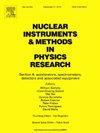Development of an optical readout Micromegas for monitoring radiotherapy gamma rays
IF 1.5
3区 物理与天体物理
Q3 INSTRUMENTS & INSTRUMENTATION
Nuclear Instruments & Methods in Physics Research Section A-accelerators Spectrometers Detectors and Associated Equipment
Pub Date : 2025-07-21
DOI:10.1016/j.nima.2025.170836
引用次数: 0
Abstract
Combining Micro-pattern gaseous detectors with optical imaging sensors, have been proven an effective method for accurate characterization of radiation beams. In response to the growing demand for large-area, real-time gamma rays dose monitoring in radiotherapy, an optical readout Micromegas detector was manufactured with a transparent indium tin oxide glass anode. Its effective area is 25 cm × 25 cm. Preliminary assessment employing X-ray sources yielded a spatial resolution of 375 m (at 10% modulation transfer function). Subsequently, the prototype was tested under clinical radiotherapy gamma rays. The results show that the linearity response exceeds 99.9% (R-squared value) for different doses. For a system-configured 100 mm field of view, the measured field size was 99.70 mm, and the penumbra width was determined to be 4.01 mm. These results indicate the good potential of this method for quality assurance in radiotherapy gamma rays. Additionally, the optical readout Micromegas is expected to be expanded to monitor other types of high-flux beams, such as medical pencil proton rays and neutron beams inspections by adding some conversion layers.
用于放射治疗伽马射线监测的光学读出器Micromegas的研制
将微图气体探测器与光学成像传感器相结合,已被证明是一种精确表征辐射光束的有效方法。为满足放射治疗中对大面积、实时伽马射线剂量监测日益增长的需求,研制了一种采用透明氧化铟锡玻璃阳极的光学读出式Micromegas探测器。其有效面积为25厘米× 25厘米。采用x射线源的初步评估得出375 μ m的空间分辨率(在10%调制传递函数下)。随后,原型机在临床放射治疗伽马射线下进行了测试。结果表明,在不同剂量下,线性响应均超过99.9% (r平方值)。对于系统配置的100 mm视场,测量的视场尺寸为99.70 mm,确定的半影宽度为4.01 mm。这些结果表明该方法在放射治疗伽马射线质量保证方面具有良好的潜力。此外,通过增加一些转换层,光学读出器Micromegas预计将扩展到监测其他类型的高通量光束,例如医疗铅笔质子射线和中子光束的检查。
本文章由计算机程序翻译,如有差异,请以英文原文为准。
求助全文
约1分钟内获得全文
求助全文
来源期刊
CiteScore
3.20
自引率
21.40%
发文量
787
审稿时长
1 months
期刊介绍:
Section A of Nuclear Instruments and Methods in Physics Research publishes papers on design, manufacturing and performance of scientific instruments with an emphasis on large scale facilities. This includes the development of particle accelerators, ion sources, beam transport systems and target arrangements as well as the use of secondary phenomena such as synchrotron radiation and free electron lasers. It also includes all types of instrumentation for the detection and spectrometry of radiations from high energy processes and nuclear decays, as well as instrumentation for experiments at nuclear reactors. Specialized electronics for nuclear and other types of spectrometry as well as computerization of measurements and control systems in this area also find their place in the A section.
Theoretical as well as experimental papers are accepted.

 求助内容:
求助内容: 应助结果提醒方式:
应助结果提醒方式:


